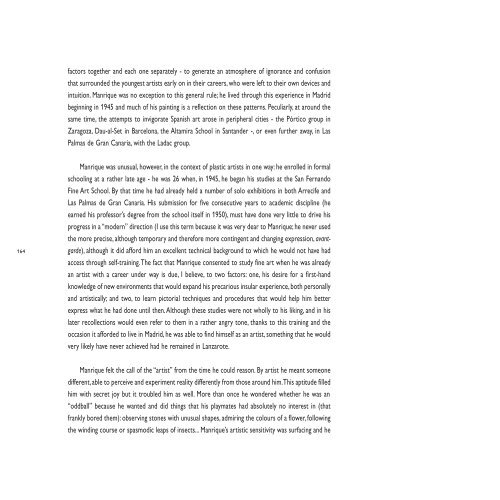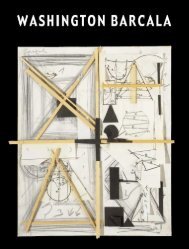VERSIÓN INGLESA ENGLISH VERSION - Fundación César Manrique
VERSIÓN INGLESA ENGLISH VERSION - Fundación César Manrique
VERSIÓN INGLESA ENGLISH VERSION - Fundación César Manrique
Create successful ePaper yourself
Turn your PDF publications into a flip-book with our unique Google optimized e-Paper software.
164<br />
factors together and each one separately - to generate an atmosphere of ignorance and confusion<br />
that surrounded the youngest artists early on in their careers, who were left to their own devices and<br />
intuition. <strong>Manrique</strong> was no exception to this general rule; he lived through this experience in Madrid<br />
beginning in 1945 and much of his painting is a reflection on these patterns. Peculiarly, at around the<br />
same time, the attempts to invigorate Spanish art arose in peripheral cities - the Pórtico group in<br />
Zaragoza, Dau-al-Set in Barcelona, the Altamira School in Santander -, or even further away, in Las<br />
Palmas de Gran Canaria, with the Ladac group.<br />
<strong>Manrique</strong> was unusual, however, in the context of plastic artists in one way: he enrolled in formal<br />
schooling at a rather late age - he was 26 when, in 1945, he began his studies at the San Fernando<br />
Fine Art School. By that time he had already held a number of solo exhibitions in both Arrecife and<br />
Las Palmas de Gran Canaria. His submission for five consecutive years to academic discipline (he<br />
earned his professor’s degree from the school itself in 1950), must have done very little to drive his<br />
progress in a “modern” direction (I use this term because it was very dear to <strong>Manrique</strong>; he never used<br />
the more precise, although temporary and therefore more contingent and changing expression, avantgarde),<br />
although it did afford him an excellent technical background to which he would not have had<br />
access through self-training. The fact that <strong>Manrique</strong> consented to study fine art when he was already<br />
an artist with a career under way is due, I believe, to two factors: one, his desire for a first-hand<br />
knowledge of new environments that would expand his precarious insular experience, both personally<br />
and artistically; and two, to learn pictorial techniques and procedures that would help him better<br />
express what he had done until then. Although these studies were not wholly to his liking, and in his<br />
later recollections would even refer to them in a rather angry tone, thanks to this training and the<br />
occasion it afforded to live in Madrid, he was able to find himself as an artist, something that he would<br />
very likely have never achieved had he remained in Lanzarote.<br />
<strong>Manrique</strong> felt the call of the “artist” from the time he could reason. By artist he meant someone<br />
different, able to perceive and experiment reality differently from those around him. This aptitude filled<br />
him with secret joy but it troubled him as well. More than once he wondered whether he was an<br />
“oddball” because he wanted and did things that his playmates had absolutely no interest in (that<br />
frankly bored them): observing stones with unusual shapes, admiring the colours of a flower, following<br />
the winding course or spasmodic leaps of insects... <strong>Manrique</strong>’s artistic sensitivity was surfacing and he
















![Becas y premios de la Fundación César Manrique [1997-2006]](https://img.yumpu.com/20766851/1/184x260/becas-y-premios-de-la-fundacion-cesar-manrique-1997-2006.jpg?quality=85)
